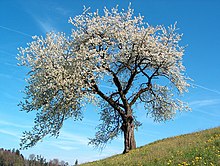| Prunus Temporal range:
| |
|---|---|

| |
| Prunus cerasus (sour cherry) in bloom | |
| Scientific classification | |
| Kingdom: | Plantae |
| Clade: | Tracheophytes |
| Clade: | Angiosperms |
| Clade: | Eudicots |
| Clade: | Rosids |
| Order: | Rosales |
| Family: | Rosaceae |
| Subfamily: | Amygdaloideae |
| Tribe: | Amygdaleae |
| Genus: | Prunus L. |
| Type species | |
| P. domestica | |
| Synonyms | |
| |
Prunus is a genus of trees and shrubs in the flowering plant family Rosaceae that includes plums, cherries, peaches, nectarines, apricots, and almonds. The genus has a cosmopolitan distribution,[3] being native to the North American temperate regions, the neotropics of South America, and temperate and tropical regions of Eurasia and Africa,[4] There are about 340 accepted species as of March 2024[update].[3][5] Many members of the genus are widely cultivated for their fruit and for decorative purposes. Prunus fruit are drupes, or stone fruits. The fleshy mesocarp surrounding the endocarp is edible while the endocarp itself forms a hard, inedible shell called the pyrena ("stone" or "pit").[6] This shell encloses the seed (or "kernel"), which is edible in some species (such as sweet almonds), but poisonous in many others (such as apricot kernels). Besides being eaten off the hand, most Prunus fruit are also commonly used in processing, such as jam production, canning, drying, and the seeds for roasting.[7]


- ^ "Rosales". www.mobot.org. Retrieved 16 June 2023.
- ^ a b c d e f g Potter, D.; Eriksson, T.; Evans, R.C.; Oh, S.; Smedmark, J.E.E.; Morgan, D.R.; Kerr, M.; Robertson, K.R.; Arsenault, M.; Dickinson, T.A.; Campbell, C.S. (2007). "Phylogeny and classification of Rosaceae". Plant Systematics and Evolution. 266 (1–2): 5–43. Bibcode:2007PSyEv.266....5P. doi:10.1007/s00606-007-0539-9. S2CID 16578516. [Referring to the subfamily by the name "Spiraeoideae"]
- ^ a b "Prunus L." Plants of the World Online. Royal Botanic Gardens, Kew. Retrieved 17 March 2024.
- ^ Chin, S.W.; Shaw, J.; Haberle, R.; Wen, J.; Potter, R. (July 2014). "Diversification of almonds, peaches, plums and cherries – Molecular systematics and biogeographic history of Prunus (Rosaceae)". Molecular Phylogenetics and Evolution. 76: 34–48. Bibcode:2014MolPE..76...34C. doi:10.1016/j.ympev.2014.02.024. PMID 24631854.
- ^ Niklas, Karl J. (1997). The evolutionary biology of plants. Chicago: University of Chicago Press. ISBN 978-0226580838. OCLC 35262271.
- ^ Velasco, Dianne; Hough, Josh; Aradhya, Mallikarjuna; Ross-Ibarra, Jeffrey (1 December 2016). "Evolutionary Genomics of Peach and Almond Domestication". G3: Genes, Genomes, Genetics. 6 (12): 3985–3993. doi:10.1534/g3.116.032672. ISSN 2160-1836. PMC 5144968. PMID 27707802.
- ^ Terry, Leon A. (2011). Health-promoting properties of fruit and vegetables. Wallingford, Oxfordshire, UK: CABI. ISBN 9781845935283. OCLC 697808315.